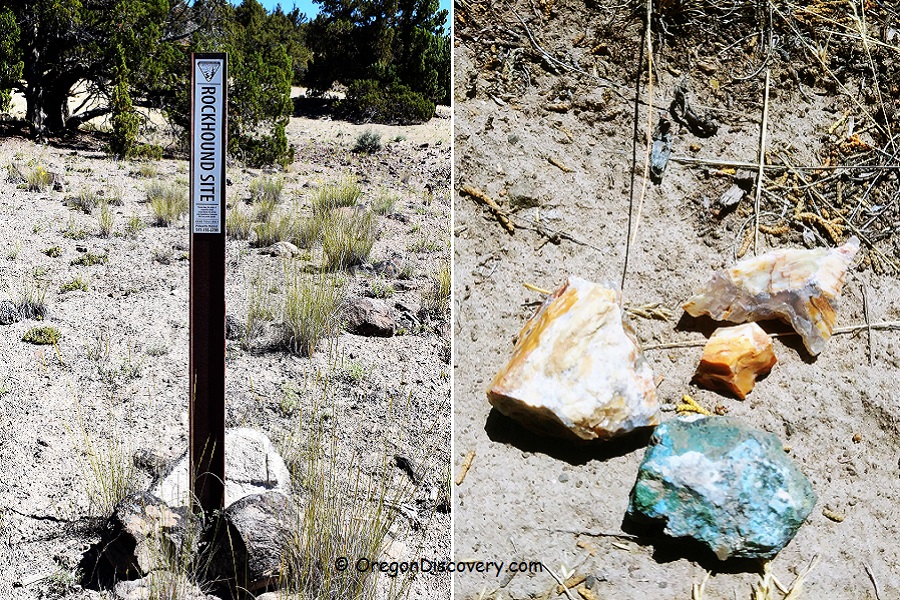
Guide to collect rocks, minerals and fossils - Rules and Regulations
• Bureau of Land Management
• US National Forest
• Rivers and Creeks
• Oregon Coast
• Oregon State Parks
• US Army Corps of Engineers
• County Parks
The ability to collect rocks, minerals, and fossils on public lands without a permit depends on several factors, including a location, the managing agency, the type of minerals or fossils, and the quantity gathered.
It is essential to follow all rules and regulations for rock collecting specific to each area you visit.
Most rock and mineral collecting sites are on federal lands managed by the Bureau of Land Management (BLM) or the U.S. Forest Service.
According to both agencies, collecting rocks and minerals for personal, non-commercial use typically does not require permits. Only hand tools, including geological picks, shovels, and jackhammers, are allowed.
Bureau of Land Management Rockhounding Regulations
The Bureau of Land Management (BLM) defines rockhounding as collecting reasonable amounts of mineral specimens, rocks, semi-precious gems, petrified wood, and invertebrate fossils.
Invertebrate fossils refer to the remains of creatures without bones, such as corals and shellfish, as well as common plant fossils.
Generally, public lands are open to rockhounding, except in areas like National Monuments. Always verify whether the land where you plan to collect rocks, minerals, or fossils is managed by the BLM, as jurisdictional boundaries may not be clearly marked.
In Oregon and Washington, BLM regulations allow a no-fee daily limit for personal-use collection of 25 pounds plus one piece. The yearly limit is 250 pounds, which includes minerals, semi-precious gemstones, common invertebrate fossils, petrified wood, and other rocks.
Only hand tools, such as shovels, picks, and hammers, are allowed for collection. Metal detectors may also be used. However, using motorized or mechanized equipment, heavy machinery, and explosives is strictly prohibited.
Groups of individuals cannot combine their yearly allowances to collect a single item that exceeds 250 pounds. For pieces larger than this limit, you must contact your local BLM office for approval.
Rockhounding is prohibited at developed recreational sites unless explicitly designated as rockhounding areas.
In Wilderness Areas, rockhounding is limited to surface collection only. It is also essential to respect laws that protect cultural and historical artifacts. Items such as Native American artifacts (e.g., arrowheads, pottery fragments, or burial remains) and vertebrate fossils (e.g., fish, mammals, or dinosaurs) cannot be collected.
Before visiting a site, check with the BLM for up-to-date regulations, specific locations, and any potential mining claims to ensure compliance.
U.S. National Forest Rock Rockhounding
The U.S. Forest Service permits recreational rockhounding on most National Forest lands.
The U.S. Forest Service limits specimen collection to 10 pounds. Some National Forest lands are closed to collecting due to wilderness designation. Contact the U.S. Forest Service for up-to-date information on specific areas.
Vertebrate fossils, such as animal, dinosaur, and fish bones, cannot be collected. Archaeological items, such as pottery fragments, arrowheads, and other artifacts, are also prohibited from being collected.
River and Creek Rockhounding Regulations
If the river or creek is designated as Essential Salmon Habitat, you may collect up to one cubic yard of wood, rocks, or gravel per year using non-motorized equipment without needing a removal-fill permit.
If the stream is designated as a State Scenic Waterway, you need a scenic waterway removal-fill permit to collect materials. However, you can collect up to 50 cubic yards of material annually from all other waterways without a removal-fill permit.
Oregon Coast Rockhounding Regulations
A particular part of the beach might be part of the Oregon State Park. In this case, follow the regulations For Oregon State Parks. However, there are some general rules for collecting materials on the Oregon Coast beaches.
You can remove no more than one gallon of agates and other non-living items such as shells, stones, and fossils per person per day, up to three gallons per person per calendar year.
Removal for Personal Use:
(4) A person may remove small quantities of natural products from the ocean shore state recreation area for personal use without a permit as provided in subsections (a) and (b). However, the department may restrict removal of natural products to specific areas of the ocean shore state recreation area, by quantities of material, and by time of year.
(a) Souvenirs that may serve as a reminder of a person’s ocean shore visit and may include a small quantity of agates and other rocks, driftwood, and similar non-living items collected for non-commercial, personal use in accordance with ORS 390.705 and 390.725. For items such as agates, sand and cobble, each person collecting must use an individual container and may not combine collections in the same container with another person. Unless otherwise restricted by the department, a person may remove:
(A) Agates and other non-living items such as shells, stones, and fossils loose on the ground, in small quantities, defined as no more than a one-gallon volume container per person per day; up to three gallons per person per calendar year.
(B) Sand: no more than a five-gallon volume container per person per day; up to 20 gallons per person per calendar year.
(C) Cobble: no more than a five-gallon volume container per person per day; up to 10 gallons per person per calendar year.
Oregon State Parks Rockhounding Regulations
Oregon State Parks allow rockhounding of small amounts of rocks, minerals, and fossils for personal collection. However, digging or otherwise disturbing park property is strictly prohibited.
At some state park locations, larger collections may be allowed upon approval of the park manager. Collecting on the ocean shore is also allowed but with specific limits.
(2) A visitor may only conduct the following activities with the written permission of the director, manager, or designated park employee unless the activity is specifically allowed by other sections of this rule:
(a) Dig up, or remove any sand, soil, rock, historical, or fossil materials;
(3) A person may remove small quantities of natural materials from a park property for personal use without written permission of the department, but only if done in accordance with the following provisions:
(a) Collection is done at a park property or portion of a park property at which the department has not specifically prohibited the removal of natural products either by location or time of year through the posting of signs, publishing of maps or brochures, or indicating on the state park website; and
(b) Collection is for souvenirs that may serve as a reminder of a person’s park visit and includes only a small quantity of agates and other rocks, driftwood, or similar non-living items collected for non-commercial, personal use.
(4) Notwithstanding section (2) or (3), a person must comply with existing state and federal rules and regulations concerning mining or the protection of public archaeological features or artifacts on state and federal lands.
US Army Corps of Engineers Rock Collecting Regulations
Rock collecting is prohibited within U.S. Army Corps of Engineers property boundaries, encompassing all reservoirs.
According to Section 327.14 of Rules and Regulations Governing Public Use of U.S. Army Corps of Engineers Land, "Removal or any alteration of natural formations, mineral deposits, historical and archaeological features, paleontological resources is prohibited except when in accordance with written permission of the District Commander."
County Parks Rockhounding Regulations
Generally, County Parks in Oregon prohibit rockhounding.
Here is one example of Marion County's regulations. According to a program coordinator of the county parks, mineral collecting falls under the provision 12.05.220 "Damaging park property which states D. Cut or remove any sand, wood, turf, grass, gravel, stone or timber in or from any park, or make any excavation by any tool, equipment, blasting or by any other means in any park".
Contact offices of the County Parks for up-to-date information.
Miscellaneous Oregon Rockhounding Regulations and Rules
In Oregon wilderness areas, rockhounding is generally permitted, but it is limited to surface collecting only. This means that you can gather rocks, minerals, and fossils that are already on the surface of the land.
Abandoned mines are extremely dangerous and must be avoided. Open shafts, deteriorated support structures, rotten timber, lack of oxygen, and various poisonous gases can result in injury or death.
Collecting material remains of prehistoric or historic human life or activities, such as arrowheads or pottery pieces, is prohibited. Vertebrate fossils (e.g., dinosaur bones, fish, and other animals with backbones) and shark teeth may not be collected.
You May Also Like
Disclaimer
Every jurisdiction can adjust its regulations for rock, mineral, and fossil collection without notice. Treat the information listed above as general rules, and always check the regulations for changes.

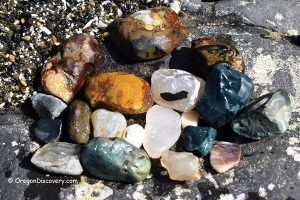
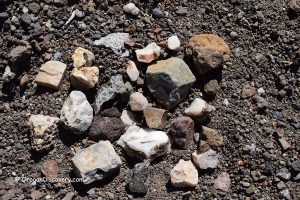


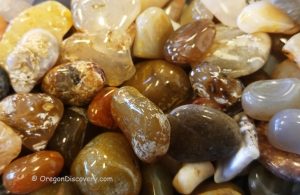
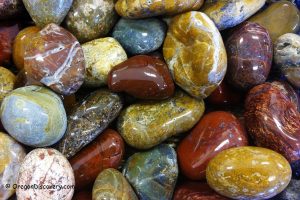


thanks sum time this year i will go mining for geodes
What do the colors on the rockhounding map stand for.
Hello, I am wanting to start a small business selling necklaces that I make using small rocks and agates I find on the beach and I am wondering what permit I would need to get in order to sell them without getting in trouble.
Thanks!